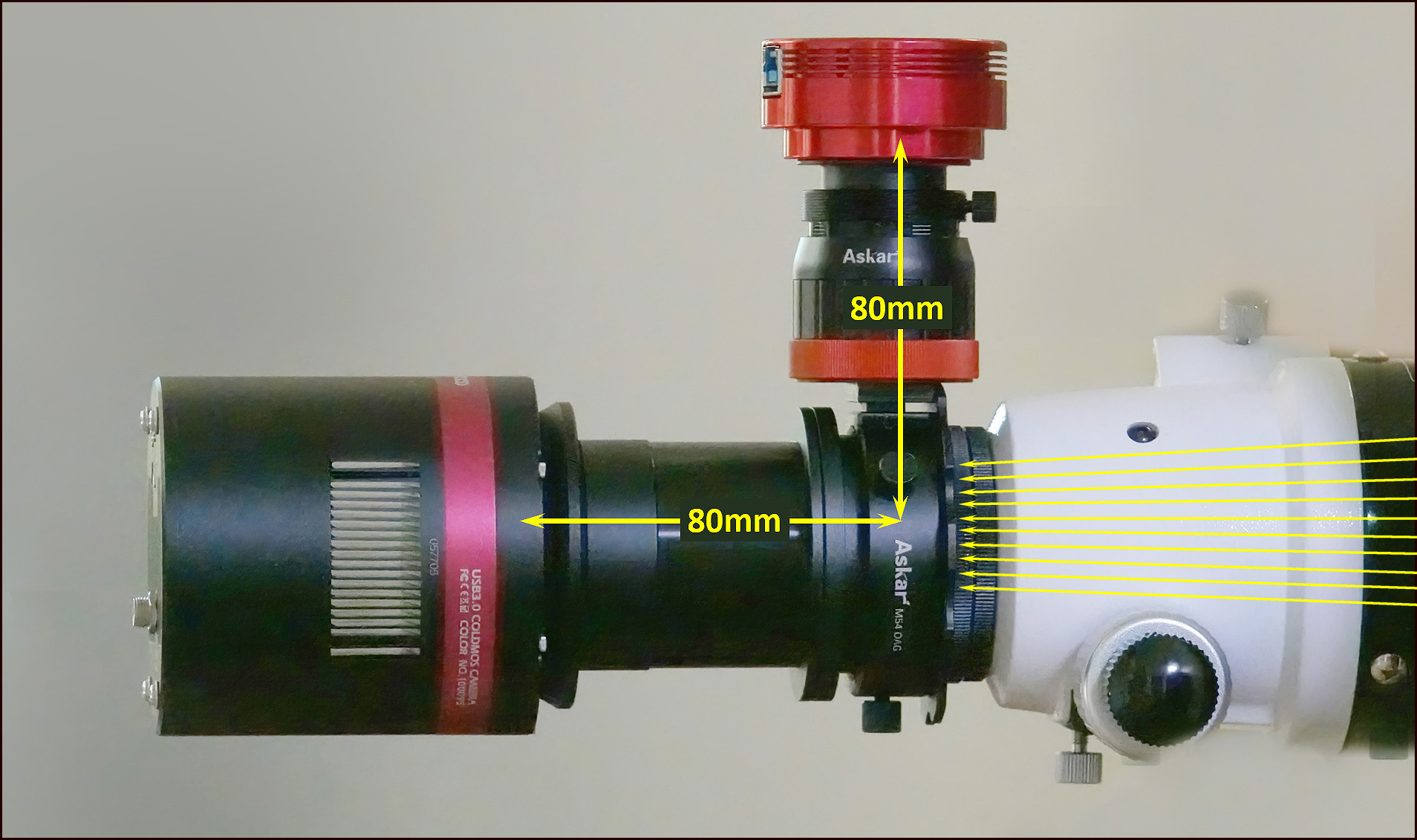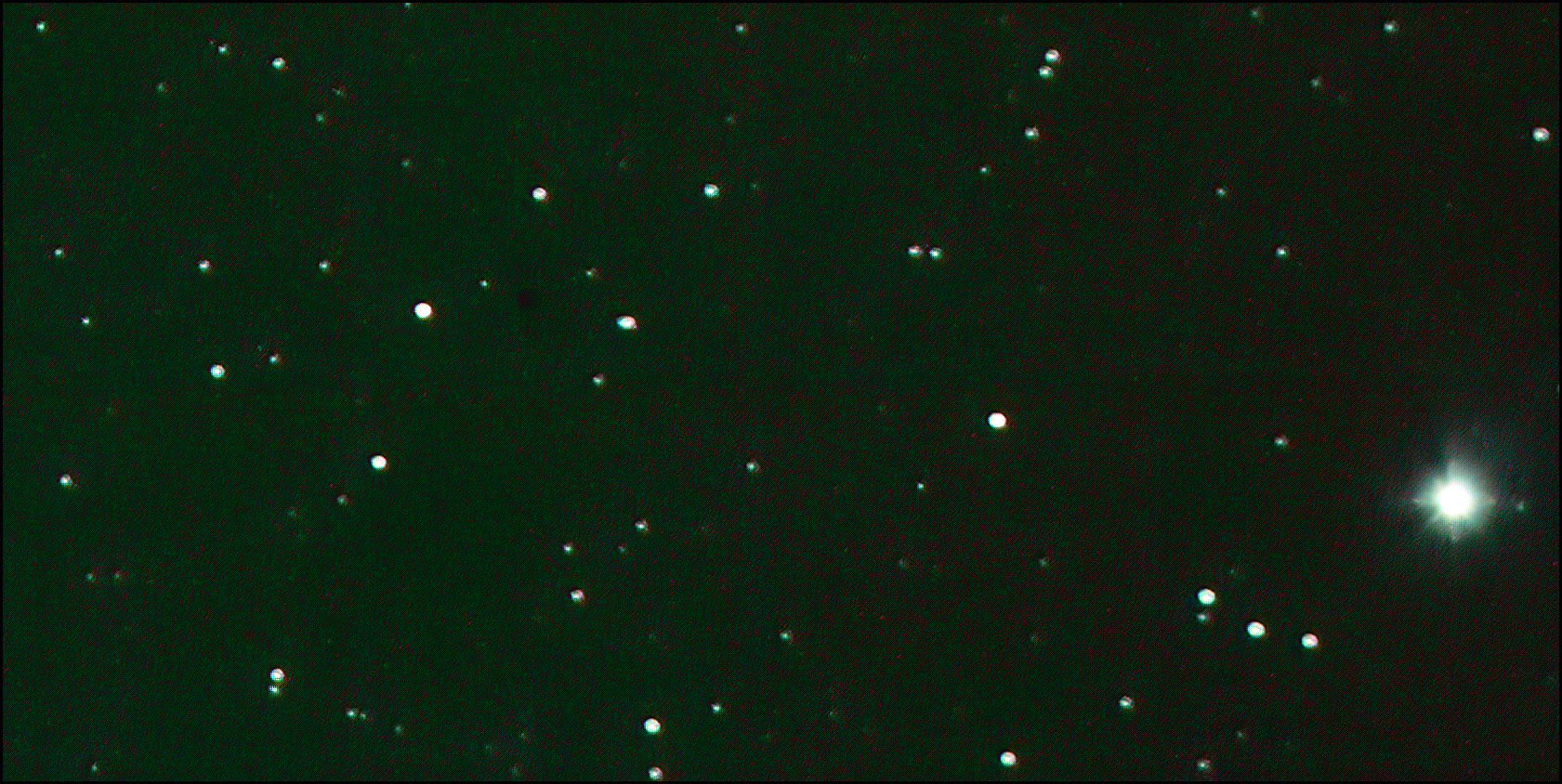On Thursday night I finally declared victory in my long twilight struggle with my telescope. It is now 100% functional.
The final hurdle was getting autoguiding to work. The telescope mount already has a motor that tracks the rotation of the earth, but it's not perfect. With just the mount tracking, I can do a 30 second exposure with my 900mm telescope, but that's about it. Anything longer and the stars look like streaks because the mount isn't tracking the sky perfectly.
Enter autoguiding. An autoguider is a separate small camera controlled by software that looks for a suitable star and then locks onto it. The camera is on a continuous loop, and whenever the star gets slightly away from where it's supposed to be, the software sends a pulse to the mount to put it back on a perfect track. With autoguiding on, I can do a 300-second exposure or more.
But it didn't work! All I got was snow and static and lousy calibration and no effect on the image at all. Until, finally, a light bulb went on in my head and I realized I had everything set up wrong. Here's an annotated picture of my optical train:
 I use a device called an off-axis guider, which contains a small prism that sends a bit of light upward into the guiding camera. What I realized is that in order for everything to be in focus—both the main camera and the guide camera—the light path had to be same length both ways. I had read about this but not paid attention, and that was my problem.
I use a device called an off-axis guider, which contains a small prism that sends a bit of light upward into the guiding camera. What I realized is that in order for everything to be in focus—both the main camera and the guide camera—the light path had to be same length both ways. I had read about this but not paid attention, and that was my problem.
The light path from the prism up to the guide camera was about 80mm. This means that the light path from the prism to the main camera also needed to be about 80mm, which in turn meant that I needed 60mm of extension tubes. As it happens, these are neither cheap nor easy to find. But in a stroke of amazing luck, I already had some long extension tubes for a different project that I had abandoned. I put in one of those along with another extension that came with the OAG, and voila! I was able to get perfect focus in both cameras.
On Thursday I took this out to test it, and after a bit of dithering around everything worked great. Focus was good; signal-to-noise ratio was fantastic; calibration was spot-on; and the software was sending pulses out to the mount with great precision.
I tested this on a 150-second exposure and it looked great. Here's a cropped section of the sky:
 The stars are all nice little circles, not stretched or streaked. That's just how it should be.
The stars are all nice little circles, not stretched or streaked. That's just how it should be.
Unfortunately, the camera giveth and the camera taketh away. You may notice that some of the smaller stars seem to have a bit of a halo around them. It turns out that after weeks of high heat, Thursday was actually a bit chilly. So my telescope dewed up. This had never happened before and I had vaguely assumed it only happened to people unlucky enough to live in places other than Southern California.
But no. Even after I had wiped off the lens as best I could, some of the fogginess stayed around and ruined the pictures.
But that's a minor problem. I went home and bought a dew heater that promises to make dew a problem of the past. It should come today and I will once again be in good shape.
Except . . . I had a wee accident. There are a few little pieces of dust on my camera sensor, so I went in yesterday to clean them off. Unfortunately, the instructions for getting access to the sensor are extremely unclear, so I ended up removing the wrong doodad. It was pretty stupid of me. Ironically, this doodad turned out to be a built-in dew heater for the piece of glass that protects the sensor, and I broke the wires connecting it to power. Will that matter? I'll find out soon enough. If it does, I'll have to send the whole camera in for repair.
But even given this little piece of idiocy, I think I'm now 100% functional and finally ready to study up and go beyond functional. I shall report back whenever the skies are clear and I can go out again.

Wow Kevin, you are the man to have figured this out. Hopefully you haven't done irreparable damage. Love the new photo. Cheers
When in doubt, read the damn instructions.
🙂
Congratulations on victory.
Indeed, as far back as the fourth grade my teachers were drilling into our heads “When all else fails, follow the directions” …
It sounds like an at least mildly Pyrrhic victory.
Aka "Read the Fine Manual" (RTFM).
I recall assembling a printer table once with an experienced programmer. I waved the instructions at him and his reply was "Where's the fun in that?"
Have you read the directions? Most directions today are written by those who know and understand for those who know and understand, making them useless for those who don’t know or understand. Best bet is to look for a how to video on YouTube.
don't attempt to clean your camera's sensor unless you absolutely know what you're doing.
Your neighbors are still very nervous…
The technophilic satisfaction of solving an obscure problem fairly jumps off the page.
This whole episode, with all the discoveries and fixes, provides a great example of why experience is so valuable and why people who have a lot of experience in some area have a depth of knowledge unavailable through merely reading a book or articles — and because experience is interactive physical reality, it is easier to remember than things merely read.
Glad it worked out and added a bit more to your depth of experience in night-sky photography.
Wow, you really jumped into the deep end -- 900mm AND an OAG. Good on ya for getting it to work. I don't recall from your earlier posts, is that a 120MM or MC? I've been working with an MC all these years but think it might be time to spend on a better one.
How do you like that Askar OAG? I'm also thinking of upgrading mine, and am looking at either the newer, bigger ZWO or the Askar. I covet a helical focuser big time.
I have no idea what the original looked like, but 150 seconds sounds kinda long for broadband. The stars in this image look pretty blown out, though of course if your intent is to dig out nebulosity and you don't care about star color, well, that's your artistic choice.
Kevin, you are such a geek!! Frankly, my eyes started to glaze over (a case of MEGO) after the third paragraph. But congrats anyway, good job.